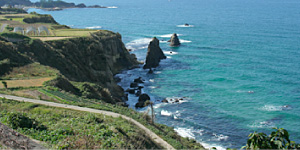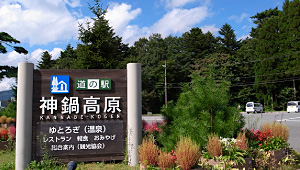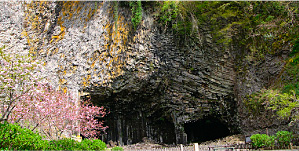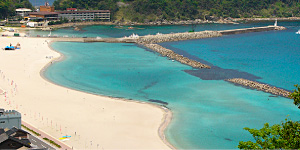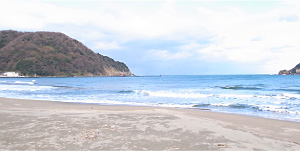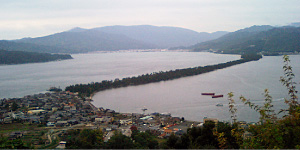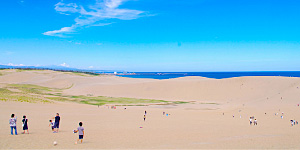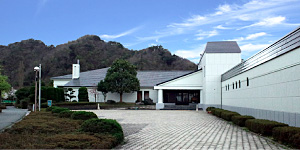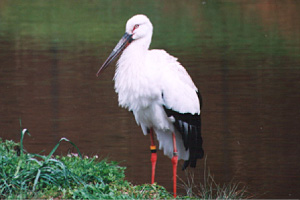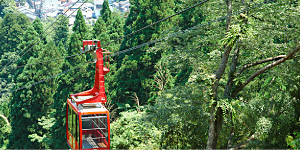Sightseeing
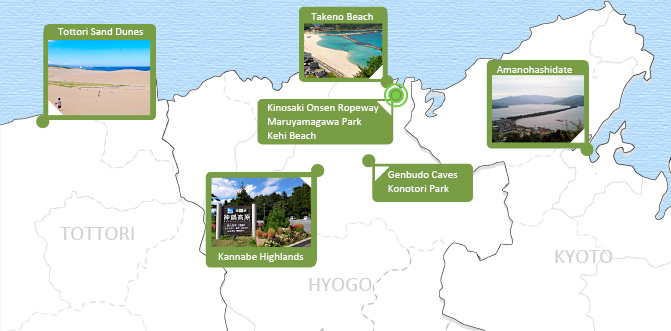
- San-in Coast Geopark
-
San-in Coast or Western Seaboard along the Sea of Japan is designated an area of scientific and geological importance. A geopark is intended to revitalize the local area by utilizing valuable geological features for education, tourism and local industry. The area is spotted with sandbars, sea caves, costal terraces, volcanos, inland waterfalls and more. These make the area renowned all over Japan for having the best scenery, spas, camping, swimming, surfing areas, and more.
Access
The San-in Coast Geopark expands the northern Kinki region. There are many points of interest that are part of the geopark. A few are listed below. For a complete list please visit: http://sanin-geo.jp/en/index_en.html
- Kannabe Highlands
-
Kannabe Highlands is an outdoor recreational area in the mountains of northern Hyogo Prefecture that provide activities year round for the whole family. In the winter the mountains are covered in a blanket of white snow making for excellent snowboarding and skiing runs. There is also a night course. When the slopes aren’t covered in snow visitors still have the option of skiing or snowboarding, or rather grass skiing or grass snowboarding. Other activities include paragliding, camping, river fishing, and many others..
Access
From Kinosaki Onsen take the San-in Line to Ebara Station. From Ebara Station take the Zentan Bus to Kannabe Kogen. About a 60 minute trip.
- Genbudo Caves
-
Genbudo Caves, called so because of the basalt (genbudo in Japanese) rocks that form the five caves. The caves are park of the Geopark. The caves and rock formations are a natural wonder formed by the cooling of lava that spewed from the volcanoes in the area. The rocks were shaped into a network of elongated multiple sided pillars, almost resembling a petrified honeycomb. The caves are located right along side the Maruyama River.
Access
From Kinosaki Station take the San-in line to Toyooka Station. Then take the Zentan Bus bound for Akaishi (赤石) then get off at the last stop. From there it’s about a 10 minute walk.
- Takeno Beach
-
Takeno Beach is one of the most popular white sanded beaches in the area. With its soft sandy beaches and clear blue waters it attracts visitors from all over Japan during the summer months. You can tell that the beach season is soon to start when the locals start setting up their stalls and booths along the beaches, to sell summer time treats to the beach goers.
Access
From Kinosaki Onsen Station take the San-in Line to Takeno Station. The beach is about a 15-20 minute walk from the station.
- Kehi Beach
-
Kehi Beach is another popular beach, and is a little closer to Kinosaki. Unlike Takeno Beach, at Kehi you are allowed to have small barbecues on the beach. There is also an area to set up tent and camp along the beach (there is a camping fee).
Access
From Kinosaki Onsen Station take the Zentan Bus bound for Mihara and Kehi (三原・気比), about a 15 minute ride.(The bus stop is between the station and Sato no Yu bath house.)
- Amanohashidate
-
Amanohashidate means “bridge to heaven” so named because of a local legend of the go Izanagi no Mikoto. It is said that he built the bridge to connect the heavens and earth so that he may travel back and forth to see his lover, Izanami no Mikoto. One day he fell asleep on Earth, failing to return to the heavens before nightfall caused the bridge to fall to Earth, now called Amanohashidate. To properly view the bridge, a 3.6 kilometer long sand bar covered with pine trees, you must turn your back to the bridge and bend over looking at it from between your legs. It may seem a little awkward, but visitors to here have been doing it for more than a millennium. Amanohashidate is also one of the three most scenic views in Japan, next to Miyajima in Hiroshima and Matsushima in Sendai.
Access
From Kinosaki Onsen Station take the San-in Line to Toyooka Station and transfer to the Kitakinki Tango Railway Miyazu Line to Amanohashidate Station
- Tottori Sand Dunes
-
Tottori Sand Dunes are another feature found along the San-in Coast. These are the only large sand dunes found in Japan. They were created over thousands of years from the redepositing of sand by the ocean’s current from the nearby Sendaigawa River. They are roughly 16 kilometers long and 50 meters high. There are a number of attractions to enjoy around the dunes. For those wanting something calm you can take a short ride along the dunes in one of the horse drawn carriages or ride on one of the camels. There is also paragliding and sand boarding lessons for the more adventurous.
Access
From Kinosaki Onsen Station take the San-in Line to Hamasaka Station. Transfer trains, staying on the San-in Line, to Tottori Station. From Tottori Station take a bus bound for the Tottori Sakyu (鳥取砂丘)from bus stop No. 0 and get off at the last stop.
- Maruyamagawa Park
-
Maruyamagawa Park is an outdoor activity center located across the Maruyama River from Kinosaki Onsen. During the warmer seasons visitors can rent kayaks or canoes to explore the Maruyama River. In the winter there is an outdoor ice-skating rink that also serves as an in line skating rink during the summer.
Access
From Kinosaki Onsen Station take the Zentan Bus bound for Kehi to Kinumaki Jinjya (絹巻神社 ). It is then about a 10 minute walk to the main facility.
- Konotori Park
-
Konotori (Oriental White Stork) is a large white stork with a wing span of up to 2.22 meters. Mainly white with black tipped wings and red surrounding the eyes. This bird was native to Japan, Korea, China and Russia. The bird was believed to have gone extinct in Japan around 1967, until 40 years later the first Konotori was successfully bred and hatched in captivity in the town of Toyooka. At the Konotori Park guests can view the these rare birds up close and learn of the efforts being taken to restore the bird’s population.
Access
Kinosaki Onsen Station take the San-in line to Toyooka Station. From Toyooka Station take the Zentan Bus to Konotori Park (コウノトリの郷公園).
- Kinosaki Onsen Ropeway
-
Kinosaki Onsen Ropeway located at the edge of the town, opposite of the station. The ropeway provides a slow and scenic ride up the mountain side in its gondola. Some of the best scenes are during the autumn changing of the leaves when the mountain is covered in orange, red, and yellow. At the bottom of the gondola visitors can also boil their own egg in the hot thermal spring waters that spurt from the ground.
Access
From Kinosaki Onsen Station walk down the main street towards the opposite end of town and Konotori no Yu bath house. The ropeway is across the street and river from Konotori no Yu. You can hike up to the top, starting from just behind the Kinosaki Onsen Shrine, or take the gondola. The gondola is up the steps on the other side of the parking lot.















